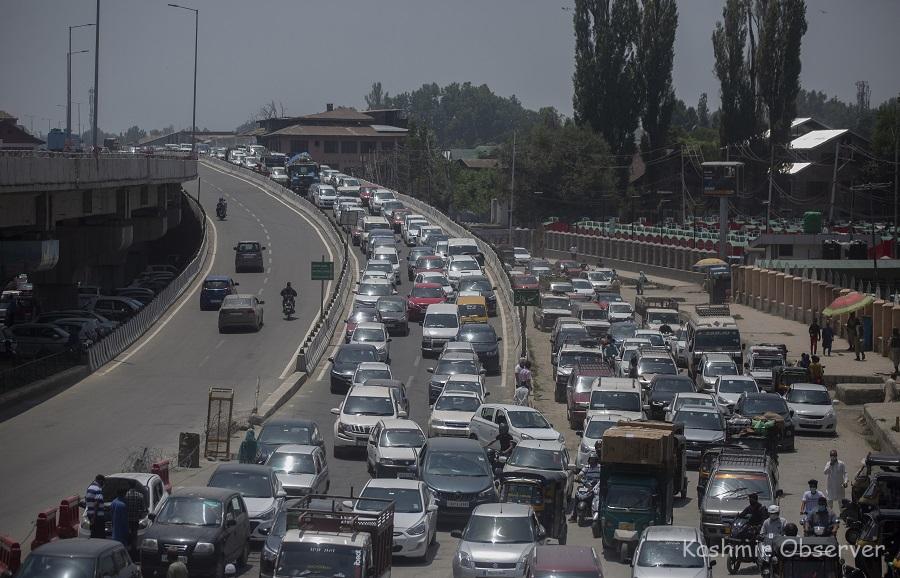
By Hilal Ahmad Dar
RECOGNIZING the dire state of traffic management in Jammu and Srinagar, the UT administration has recently directed concerned officers to devise a comprehensive plan that addresses short-term and long-term requirements. While this initiative is a step in the right direction, it is important to critically analyse existing bottlenecks and associated factors to develop an effective strategy. In the absence of wider roads, flyovers, metro rail services, and other infrastructural developments, certain measures can be adopted to alleviate the traffic situation. This article explores some potential solutions that can contribute to easing traffic congestion in the cities.
Parking Management:
Launch a campaign against vehicles parked on roads, addressing both the manner and method of parking. Strict enforcement against vehicles causing obstruction or inconvenience should be undertaken. However, alternative parking options must be provided to vehicle owners to avoid exacerbating the problem. Encourage the development of multi-level parking facilities in congested areas to provide adequate parking space without consuming additional road space.
Deviation for Passenger Vehicles:
Implement designated stopping points for passenger vehicles to pick up and drop off passengers/staff/students. This will prevent long queues of vehicles and minimize traffic congestion caused by haphazard stops. Create dedicated zones for boarding and deboarding near schools, colleges, and other busy areas to streamline the movement of passenger vehicles.
Minimum Speed Limits:
Introduce minimum speed limits to discourage crawling traffic caused by passenger vehicles engaged in boarding and deboarding activities. This will ensure a smoother flow of vehicles and prevent unnecessary traffic jams. Implement speed-monitoring devices and enforce penalties for vehicles impeding the traffic flow below the prescribed minimum speed limit.
Provision of Parking Lots:
Establish paid parking lots at short distances throughout the cities to discourage erratic and haphazard parking. This will encourage drivers to utilize designated parking spaces, reducing on-street parking congestion. Explore the feasibility of constructing parking lots near major commercial areas, tourist attractions, and public transportation hubs to encourage commuters to park their vehicles and use alternative modes of transportation.
Overnight Parking Regulations:
Strictly prohibit overnight parking of vehicles on public roads and lanes. This will help keep roads clear for normal traffic movement and ensure unobstructed access for emergency services. Collaborate with local communities and residents to identify suitable overnight parking areas, such as unused open spaces or private parking lots, and provide them with secure parking options.
Traffic Rules Awareness:
Promote awareness of traffic rules among the general public through educational campaigns and community engagement. This will foster a culture of responsible driving and contribute to more effective traffic management. Conduct regular road safety awareness programs in schools, colleges, and workplaces to educate individuals about traffic rules, safe driving practices, and the importance of following traffic regulations.
Addressing Vehicle Registration:
Make vehicle registration conditional upon the prospective owner having sufficient space for overnight parking. Legislative measures can be considered to enforce this requirement, ensuring that vehicles are not added to the streets without adequate parking arrangements. Conduct regular inspections to ensure compliance with parking requirements and impose penalties for violations.
Time Restrictions for Heavy Vehicles:
Restrict heavy vehicles, such as loaded trucks, from plying during peak hours to minimize congestion. By regulating the movement of these vehicles, traffic flow can be improved during crucial periods. Collaborate with relevant stakeholders, such as transportation companies and logistics associations, to establish designated time slots for heavy vehicle movement and enforce compliance through strict monitoring.
Increased Deployment of Traffic Personnel:
Deploy a greater number of traffic personnel on the roads to monitor and enforce traffic rules. Their visible presence will act as a deterrent to traffic violations and promote compliance among drivers. Conduct regular training programs for traffic personnel to enhance their skills and knowledge of traffic management techniques. Utilize technology, such as traffic cameras and real-time monitoring systems, to assist traffic personnel in effectively managing traffic flow.
Infrastructure Development:
Invest in the development of infrastructure to accommodate the growing vehicular population. Explore options such as widening existing roads, constructing flyovers and underpasses at congested intersections, and implementing intelligent transportation systems. Collaborate with urban planners and experts to design efficient road networks that can handle increased traffic volume and ensure smooth traffic flow.
Addressing the traffic challenges in Jammu and Srinagar requires a multi-faceted approach, encompassing effective parking management, passenger vehicle regulations, speed enforcement, public awareness campaigns, and infrastructure development. While these measures can provide temporary relief, it is imperative to invest in long-term infrastructure development and explore innovative solutions to ensure smoother traffic flow. By adopting a comprehensive and proactive approach, the UT administration can pave the way for a more efficient and organized traffic management system in Jammu and Srinagar. With proper planning, community engagement, and continuous monitoring, the abundance of vehicles can coexist with limited roads, ensuring a safer and more sustainable transportation environment for all.
- The author is a government employee
Follow this link to join our WhatsApp group: Join Now
Be Part of Quality Journalism |
Quality journalism takes a lot of time, money and hard work to produce and despite all the hardships we still do it. Our reporters and editors are working overtime in Kashmir and beyond to cover what you care about, break big stories, and expose injustices that can change lives. Today more people are reading Kashmir Observer than ever, but only a handful are paying while advertising revenues are falling fast. |
| ACT NOW |
| MONTHLY | Rs 100 | |
| YEARLY | Rs 1000 | |
| LIFETIME | Rs 10000 | |










